Caring for an axolotl isn’t very hard but if it’s your first time, learning the basics of axolotl care is vital to providing good living conditions for your pet. That’s where this care guide comes in!
In this axolotl care sheet, you’ll learn exactly how to care for axolotls, what they eat, the type of enclosure they need, as well as other vital parts of axolotl care.
So, without further ado, let’s get into the care sheet!
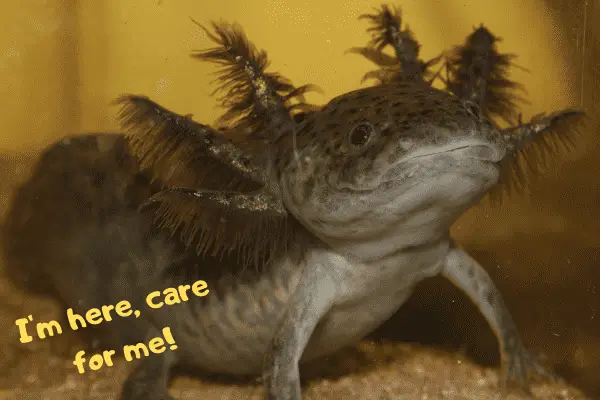
Table of Contents
Are axolotls good pets?
These strange-looking fish/reptiles/aliens are certainly interesting to look at, but do axolotls make good pets?
You can’t go wrong with these cute little amphibians. Axolotls make great pets, especially if you’re looking for something that’s less demanding than a dog, or even a reptile.
Learn more about the differences between reptiles and amphibians here!
They’re great to look at and display some extremely interesting behaviors once they get used to their enclosure.
Learning how to care for an axolotl is simple too. There’s a lot of information online that helps you to learn exactly what axolotl care is all about.
Can you hold an axolotl?
When it comes to handling, these pets fall short. Unfortunately, axolotls have very sensitive skin which gets damaged easily. It’s best not to touch your axolotl at all, and especially not take them out of the water.
They make for great display animals though and are an extremely interesting species to look at and observe.
Is an axolotl an amphibian?
Yes, axolotls are amphibians.
Axolotl lifespan
How long axolotls live for varies a lot depending on their care. An Axolotl’s lifespan can stretch for a good 10 – 15 years if they don’t run into any health issues.
In the wild, an axolotl’s lifespan could be shortened by predators, environmental conditions or even a lack of food. However, axolotls are extinct in the wild, so this isn’t something we need to cover. There are also sources that say axolotls aren’t quite extinct, but even if this is the case their numbers are dwindling.
Luckily, they thrive in captivity, and an axolotl’s lifespan in captivity is probably a lot longer than they were in the wild.
They’re also prevalent in research labs and other scientific facilities due to some extraordinary features these little munchkins possess. Axolotls have the ability to regenerate almost every body part. This makes them very interesting animals to study since properties like this could be very useful when treating a vast array of different diseases and illnesses.
We hope that these studies are all done ethically and without harming the animals!
How big do axolotls get?
Adult axolotls get to be about 7 to 12 inches in length. There have been records of axolotls growing upwards of 14 inches though, so you may be surprised at how big yours gets!
Their size is down to a mixture of their genetics as well as their care. If there are any incidents while they’re still growing, an axolotl’s size could end up being smaller than most.
Their size also means that an axolotls enclosure doesn’t take up too much space which makes them more accessible as pets.
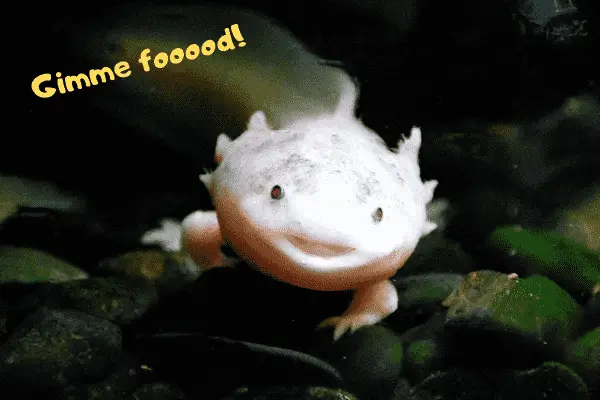
Axolotl food
When it comes to what to feed axolotls, it’s another walk in the park. Unlike most animals featured on this site, an Axolotl’s food doesn’t need to be dusted with any sort of vitamin or mineral supplement.
This is fortunate since dusting food to then drop into the water for feeding wouldn’t work out very well. You’d be spending your time scraping the supplement off the surface of the water and your axolotl wouldn’t get to see the benefits of it.
They are easy to raise on just 1 or 2 different food types which makes axolotl care even easier for you!
Axolotls don’t have very useful teeth when it comes to chewing food, so they swallow their meals whole. Keep this in mind, as whatever you feed them should fit in their mouth whole too!
Feeding them food items which are too large can harm your pet axolotl so think things through before feeding them!
They’re carnivorous, which means they survive off a diet of other animals. There are options that don’t involve feeding live animals though.
What do axolotls eat?
Earthworms are a staple and one of the best foods to feed axolotls. There are other species of worms you can feed your axolotl, but it won’t make much difference to them. Varying things every so often may provide them with some enrichment though and is recommended.
Some of your options are nightcrawlers, blood worms or black worms. It’s important that you get these worms from a trusted source and are confident that they’re free from diseases and parasites.
Most aquarium stores will have at least one of these options in stock.
Another option is to go with pellets, like salmon pellets. These aren’t great for juveniles but as your axolotl gets older, they work great. They’re also easy to store, however, it may be difficult to get your axolotl to start eating these. Movement is an important stimulus to get a proper feeding response from your axolotl. This is why pellets don’t always work and take some work for them to get used to.
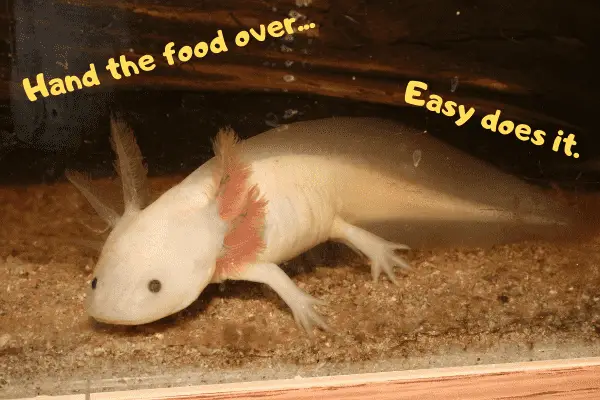
How to feed axolotl
Axolotls eat from the bottom of the tank. They won’t come to the top as fish do, so this is something to keep in mind. This can be an issue when it comes to pellets since oftentimes these will float. Luckily, they’ll sink over time, but this isn’t ideal for feeding.
If the pellets you bought float, place them in a little cup of water until they sink. It will then be much easier to feed them to your axolotl. If you drop them near your pet they will see the movement and this may encourage them to go for the pellet.
Movement is what triggers their feeding response. If a pellet sinks to the bottom without it being near to your axolotl’s head, the chances are that the pellet will just sit at the bottom of your tank until you clean it!
Using some tweezers is another great way to feed axolotls. This prevents mess from going everywhere and also allows you to provide some movement to get a good feeding response.
Just holding the food in front of them and wiggling it around slightly should do the trick nicely!
Just be careful that the tweezers aren’t too hard or sharp, and that you try to prevent them from biting the tweezer too often. It wouldn’t do your mouth much good if you latched onto your fork every time you took a bite and it’s not great for axolotls either!
how often to feed axolotl
You should feed your axolotl about three times per week. Every two to three days works well because they need time to digest their food. If your axolotl doesn’t eat, wait 12-24 hours and try again. As with most animals, they may reject food when they’re not hungry.
This being said, it’s best to watch out for overfeeding too. It’s common for captive salamanders to suffer the effects of overfeeding.
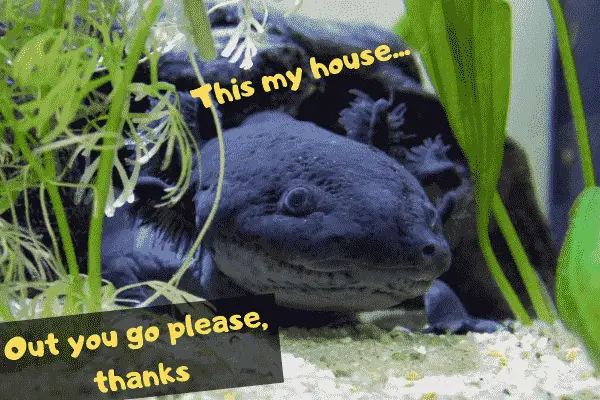
Housing
Axolotl housing is another simple part of axolotl care. These amphibians don’t need many crazy things in their aquarium, nor do they need very many special water/heating conditions. That being said, there are a few things to look out for…
Tank size for Axolotls
A small 10-15 gallon tank is fine for housing an axolotl in. However, providing your axolotl with a larger aquarium, about 20 to 30 gallons, will make it easier to provide them with proper care.
This is because the waste they produce can build up, and a small tank will make this process go a lot quicker. It’s also much more exciting watching your axolotls enjoy a larger tank and they will usually display much more versatile behavior in a larger tank with more stimulation.
Getting them a larger tank will help to improve the water conditions and give them more space to enjoy.
We recommend this tank from amazon
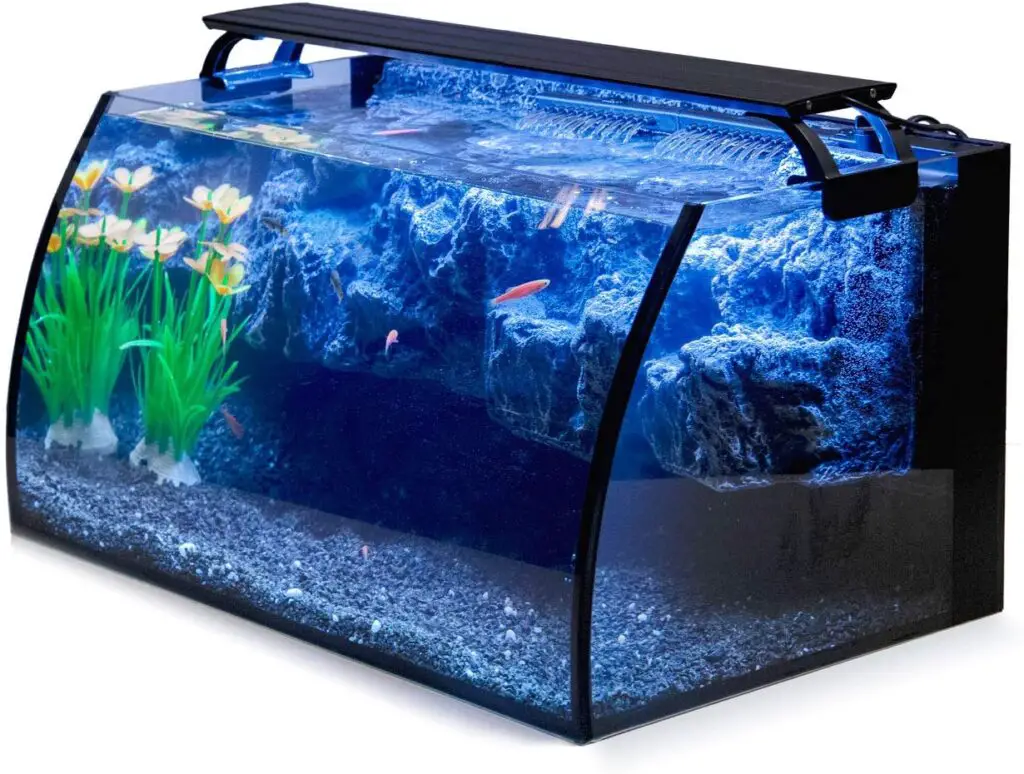
Can axolotls live on land?
No, axolotls cannot live on land. They only live in the water, sometimes coming up to breathe but they will never leave the water. There’s also no need to provide them with a land area, even though they do have legs!
Where do axolotls live?
Before they grew extinct, axolotls used to inhabit a lake in Mexico. This one lake was, at the time, the only place where these animals could be found in the wild. Luckily, they thrive in captivity. Even though they don’t exist in the wild anymore, there’s still a thriving population of pet axolotls who can enjoy life and keep the species alive.
Can you hold an axolotl out of water?
No, this is not advised. Axolotls have very sensitive skin which shouldn’t be touched, nor should it be removed from the water. Their skin is extremely delicate and is permeable too. This means that not only can you damage their skin, you can also very easy infect them with various bacteria or chemicals.
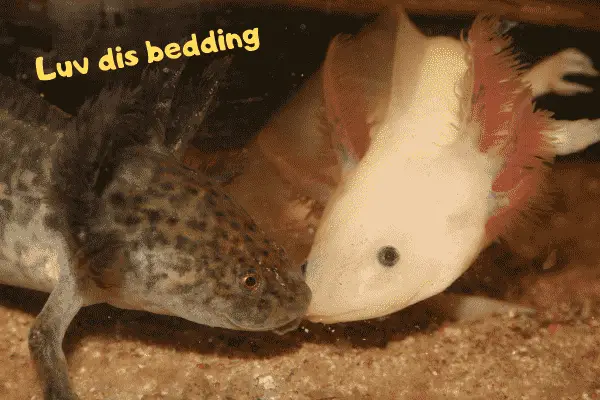
Substrate
Axolotl substrate is a topic which is far less debated than most other reptiles and amphibians. There are a few things to remember when choosing axolotl substrate.
The first is, never pick a substrate that is the same size, or smaller than their head. Anything like stones, pebbles or gravel that can fit in their mouth, may end up there. If these particles are small then this isn’t always so bad, but if they are large then it could get stuck in their mouth and cause a lot of harm to your pet.
Even though very small particles like aquarium sand may be able to cause impaction, this doesn’t happen often. Axolotls don’t have the tendency to eat very small particles, and a small amount doesn’t do much harm. This is why it’s best to go with some kind of aquarium sand, or even better would be to go this a bedding that’s stuck onto the bottom of the tank. There are also a lot of people who advise against any form of substrate, but visually this isn’t so appealing.
All in all, a special aquarium sand substrate works fine. If you notice any problems or you see your axolotl eating away at the sand, just remove it!
Temperature
Temperature-wise, axolotls like it cold. They need the water to be in the range of 60-70 degrees Fahrenheit (roughly 15 to 21 degrees Celsius), between 65 and 70 degrees Fahrenheit is ideal. Water which rises above this temperature is not healthy for your axolotl and can lead to stress and eventually death.
In most houses, the temperature will be higher than this during some summer weeks and it’s therefor a good idea to get an aquarium chiller. If you’re in an area where it rarely passes these temperatures, finding a cooler spot in the house during the summer should work fine.
A thermometer that can measure the water temperature is mandatory when keeping axolotls. Luckily these thermometers are cheap.
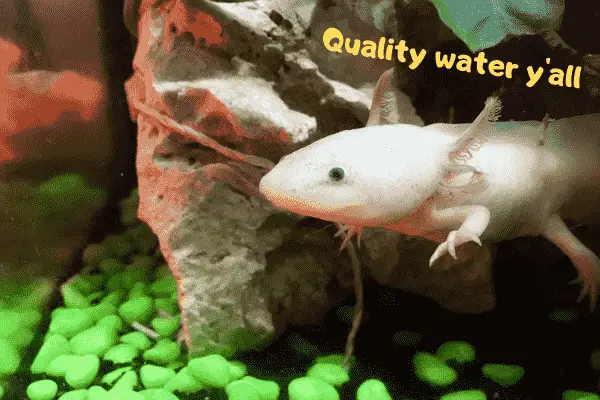
Water quality and flow
The water in your aquarium needs to be free from chlorine and other contaminates. This is usually done using special aquarium conditioner kits. If you use one of these kits, tap water usually works fine. Axolotls are a hardy amphibian to keep and are therefor a forgiving pet when it comes to small mistakes.
Obviously, you’ll also need a filter to filter the water and prevent it from getting toxic. Housing your axolotl in a larger aquarium also helps to keep toxin counts down. A good filter will further help to keep the water safe for your pet axolotl. Testing the water regularly is important in any aquarium and this is true when housing axolotls too.
Water flow
The speed of water flow is a major cause of stress in axolotls. This is another reason why a slightly larger tank is beneficial as the currents will not be as strong throughout the whole aquarium. It’s best to reduce the current in the aquarium as much as possible to prevent stress in your axolotls. Some things you can try are:
- Pointing the filter against the tank wall or an object
This helps to deflect the strongest water flow and points it away from where your axolotls are. You can also place a rock or some other object in front of the current to prevent it from being too strong.
- You can choose to buy or make a spray bar that reduces the strength of the current
This youtube clip shows you how you can build your own spray bar to improve your axolotl’s living conditions
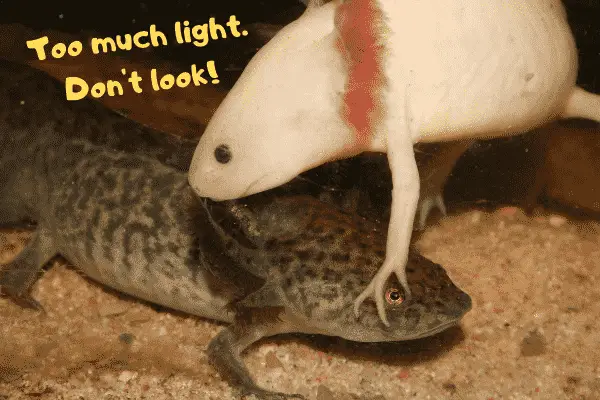
Lighting
Axolotls don’t need any special lighting. These little critters aren’t accustomed to a bright aquarium and shouldn’t be kept in a tank that’s too lit up. There are special lights though that can help you light up the aquarium without it harming your pet.
That being said, if you need lighting for your aquarium plants to grow, then providing your axolotls with some darker areas works great too. You can also use the plants to prevent the light from penetrating too deep into the tank
Buying your axolotl – Availability and selection
When you go to buy your axolotl there are multiple things you should look out for to ensure you get the right one for you. This part of the post is dedicated to choosing and buying an axolotl.
Morphs
The first thing you need to consider is the morph you want to get. The most common and well-known morphs are the natural/wild-type, albino and leucistic morphs. There are however very unique morphs which are lightly (or heavily) fluorescent, ones who have high melanin levels (darker color) and many different other pattern variations too.
Most of these morphs are relatively inexpensive, and the albino and leucitic ones are the most common. Since this pet will be with you for up to 15 years, it’s best to go with one you like!
Checking for health
Even though you’re no expert, there are certain checks you can do to the axolotl and the setup that will help you determine if they are in good shape.
Axolotls that float in strange ways (on their back or side), or that are showing other signs of stress like forward-facing gills or a curled tail, aren’t the best ones to go for. Stress causes a lot of harm to an animal and may cause you to say goodbye to your axolotl before you get a chance to enjoy each other’s company.
Missing limbs, blemishes or marks may also be a sign of an unhealthy animal. Healthy axolotls will regenerate body parts unless they are infected. It’s not always bad when they don’t regenerate a minor body part but it may be a sign of sickness and is therefore not ideal when buying an axolotl.
Checking the setup
The most important thing you can do to check the health of an axolotl is to see the conditions they are being kept in. After reading this entire guide you have all the information you need to judge how the animals are being kept. If the conditions are right then you can be sure that the breeder takes care of their animals.
If they have other animals, take a look at how they’re being cared for too. Sure, this doesn’t always reflect how they care for their axolotls but it can tell you a lot about their general animal care. Axolotls don’t have very tricky requirements so keeping them in clean and safe conditions isn’t a stretch for anyone. This means that your breeder should be doing a good job!
Transport
If you ever need to transport your axolotl, or you need to move it into a temporary set up due to infection or due to you needing to clean the cage, then here are a few tips for you:
- Use a net with very fine mesh
Wide mesh may cause limbs or toes to get stuck or injured. Even though axolotls can usually regenerate body parts, you shouldn’t cause them harm on purpose. By getting a fine mesh net when scooping up your axolotl you prevent any harm from being done.
- Be careful!
Above all, be careful when you have to move your axolotl. As we’ve already discussed, their skin is permeable and delicate, and so are their limbs. By being careful and using clean equipment you prevent infections and injuries.
Even though axolotls are very hardy animals, it’s best to take good care or them. A small mistake here or there usually won’t cause any long-term damage, but it’s best to try and prevent this from happening.
Disease and illness
If you think your axolotl may be suffering from a disease or illness, go to the vet. It’s best to find a vet that specializes in exotic animals. There’s no telling what could be going on and you shouldn’t be reading a care guide to treat something unknown. There are a few common mishaps that aren’t too much trouble if you know what to do though.
Injury
If your axolotl gets injured, make sure to keep their water clean and prevent them from doing any more damage to themselves. Keep a close eye on the wound, it should heal fairly quickly. If it doesn’t, or it looks like it’s infected, then go and see a vet. They’ll be able to treat a normal injury.
Axolotl not eating
Axolotls that stop eating is another problem that isn’t always a major cause for concern. Check for signs of stress (floating, curled tail, etc) and check to see if your husbandry is on point. A simple slip of the filter outlet or a rise in the room temperature may cause temporary stress to your axolotl.
Do some detective work and measure your husbandry up to this (or another) care guide.
If you find anything, make sure to tackle the issue straight away. Your axolotl will usually start eating again soon.
If your husbandry is on point, take your axolotl to the vet. With perfect husbandry, these things shouldn’t happen.
Conclusion
All in all, axolotls make for great pets if not handling your pet isn’t a problem for you. They’re beautiful creatures who deserve their place among the best and most common pet amphibians around.
They’re easy to care for and don’t require a lot of specialized care once you know what you’re doing.
